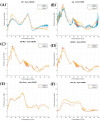Effects of Physiological Loading from Patient-Derived Activities of Daily Living on the Wear of Metal-on-Polymer Total Hip Replacements
- PMID: 40564479
- PMCID: PMC12189450
- DOI: 10.3390/bioengineering12060663
Effects of Physiological Loading from Patient-Derived Activities of Daily Living on the Wear of Metal-on-Polymer Total Hip Replacements
Abstract
The current pre-clinical testing standards for total hip replacements (THRs), ISO standards, use simplified loading waveforms that do not fully replicate real-world biomechanics. These standards provide a benchmark of data that may not accurately predict in vivo wear, necessitating the evaluation of physiologically relevant loading conditions. Previous studies have incorporated activities of daily living (ADLs) such as walking, jogging and stair negotiation into wear simulations. However, these studies primarily used simplified adaptations that increased axial forces and applied accelerated sinusoidal waveforms, rather than fully replicating the complex kinematics experienced by THR patients. To address this gap, this study applied patient-derived ADL profiles-jogging and stair negotiation-using a three-station hip simulator, obtained through 3D motion analysis of total hip arthroplasty patients, processed via a musculoskeletal multibody modelling approach to derive realistic hip contact forces (HCFs). The results indicate that jogging significantly increased wear rates compared to the ISO walking gait waveform, with wear increasing from 15.24 ± 0.55 to 28.68 ± 0.87 mm3/Mc. Additionally, wear was highly sensitive to changes in lubricant protein concentration, with an increase from 17 g/L to 30 g/L reducing wear by over 60%. Contrary to predictive models, stair descent resulted in higher volumetric wear (8.62 ± 0.43 mm3/0.5 Mc) compared to stair ascent (4.15 ± 0.31 mm3/0.5 Mc), despite both profiles having similar peak torques. These findings underscore the limitations of current ISO standards in replicating physiologically relevant wear patterns. The application of patient-specific loading profiles highlights the need to integrate ADLs into pre-clinical testing protocols, ensuring a more accurate assessment of implant performance and longevity.
Keywords: activities of daily living; joint simulator testing; physiological loading; total hip replacement.
Conflict of interest statement
The authors declare no conflict of interest.
Figures





Similar articles
-
How Patients' Lifestyle Affects the Wear of Hip Implants: An In-Silico Study.J Orthop Res. 2025 Aug;43(8):1472-1484. doi: 10.1002/jor.26098. Epub 2025 May 15. J Orthop Res. 2025. PMID: 40372250
-
A rapid and systematic review of the clinical effectiveness and cost-effectiveness of paclitaxel, docetaxel, gemcitabine and vinorelbine in non-small-cell lung cancer.Health Technol Assess. 2001;5(32):1-195. doi: 10.3310/hta5320. Health Technol Assess. 2001. PMID: 12065068
-
Cost-effectiveness of using prognostic information to select women with breast cancer for adjuvant systemic therapy.Health Technol Assess. 2006 Sep;10(34):iii-iv, ix-xi, 1-204. doi: 10.3310/hta10340. Health Technol Assess. 2006. PMID: 16959170
-
Intravenous magnesium sulphate and sotalol for prevention of atrial fibrillation after coronary artery bypass surgery: a systematic review and economic evaluation.Health Technol Assess. 2008 Jun;12(28):iii-iv, ix-95. doi: 10.3310/hta12280. Health Technol Assess. 2008. PMID: 18547499
-
What is the value of routinely testing full blood count, electrolytes and urea, and pulmonary function tests before elective surgery in patients with no apparent clinical indication and in subgroups of patients with common comorbidities: a systematic review of the clinical and cost-effective literature.Health Technol Assess. 2012 Dec;16(50):i-xvi, 1-159. doi: 10.3310/hta16500. Health Technol Assess. 2012. PMID: 23302507 Free PMC article.
References
-
- W-Dahl A., Kärrholm J., Rogmark C., Nåtman J., Bülow E., Ighani Arani P., Mohaddes M., Rolfson O. The Swedish Arthroplasty Register Annual Report 2023. Swedish Arthroplasty Register; Gothenburg, Sweden: 2023.
-
- Evans J.T., Evans J.P., Walker R.W., Blom A.W., Whitehouse M.R., Sayers A. How long does a hip replacement last? A systematic review and meta-analysis of case series and national registry reports with more than 15 years of follow-up. Lancet. 2019;393:647–654. doi: 10.1016/S0140-6736(18)31665-9. - DOI - PMC - PubMed
-
- Bayliss L.E., Culliford D., Monk A.P., Glyn-Jones S., Prieto-Alhambra D., Judge A., Cooper C., Carr A.J., Arden N.K., Beard D.J., et al. The effect of patient age at intervention on risk of implant revision after total replacement of the hip or knee: A population-based cohort study. Lancet. 2017;389:1424–1430. doi: 10.1016/S0140-6736(17)30059-4. - DOI - PMC - PubMed
Grants and funding
LinkOut - more resources
Full Text Sources
Miscellaneous

